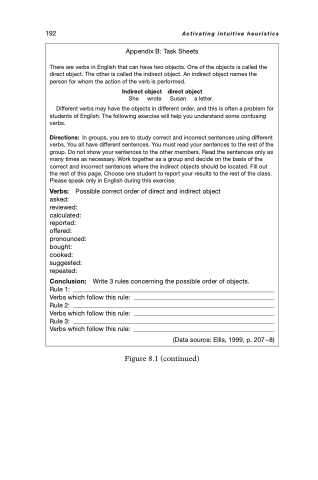Page 204 - Beyond Methods
P. 204
192 Activating intuitive heuristics
Appendix B: Task Sheets
There are verbs in English that can have two objects. One of the objects is called the direct object. The other is called the indirect object. An indirect object names the person for whom the action of the verb is performed.
Indirect object direct object
She wrote Susan a letter.
Different verbs may have the objects in different order, and this is often a problem for students of English. The following exercise will help you understand some confusing verbs.
Directions: In groups, you are to study correct and incorrect sentences using different verbs. You all have different sentences. You must read your sentences to the rest of the group. Do not show your sentences to the other members. Read the sentences only as many times as necessary. Work together as a group and decide on the basis of the correct and incorrect sentences where the indirect objects should be located. Fill out the rest of this page. Choose one student to report your results to the rest of the class. Please speak only in English during this exercise.
Verbs: Possible correct order of direct and indirect object asked:
reviewed:
calculated:
reported: offered: pronounced: bought: cooked: suggested: repeated:
Conclusion:
Rule 1:
Verbs which follow this rule: Rule 2:
Verbs which follow this rule: Rule 3:
Verbs which follow this rule:
Write 3 rules concerning the possible order of objects.
(Data source: Ellis, 1999, p. 207–8)
Figure 8.1 (continued)


